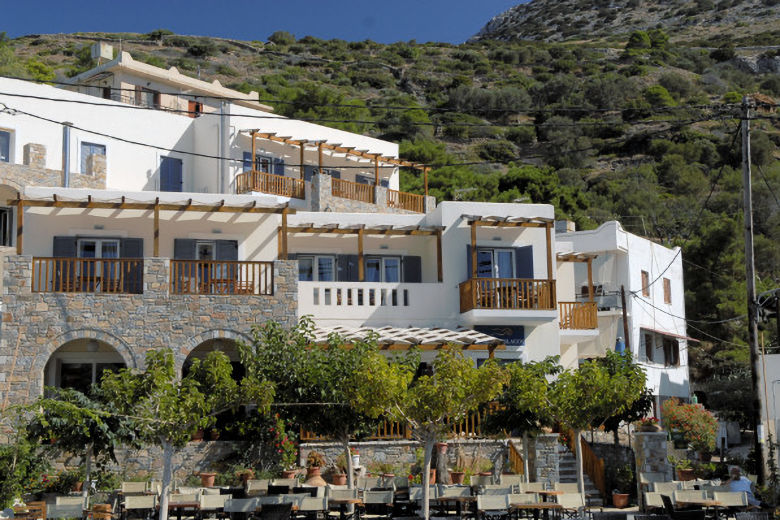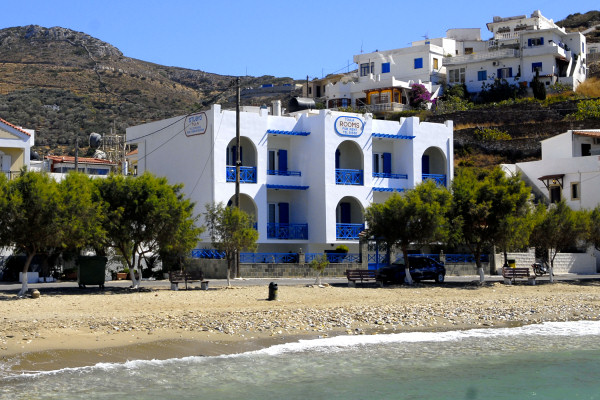Lying just south of the straits that divide Samos and Ikaria, the Fourni Islands, as they are collectively known, are a cluster of inkblot-shaped islands, their slender tips almost intertwined and creating in their folds coves that are so sheltered that their waters are often as calm as the proverbial millpond.
Some of the islets are little more than craggy rocks, inaccessible and uninhabited, and of the two islands that do boast a human population, Thymena really is just a little too oblivious to tourism and too lacking in facilities to make it a suitable holiday base.
Fourni itself, on the other hand, strikes just the right balance in more ways than one. The island is small enough for its main attractions to be easily explored on foot, yet large enough to not feel claustrophobic. Its laid-back atmosphere offers travellers an escape from the stresses of the modern world, yet there is enough going on to sustain an active local community all year round, with fishing, boat-building and bee-keeping the main sources of employment. And as the island has been attracting a small but surprisingly diverse band of visitors from all over Europe and further afield for a number of years, it can feel almost cosmopolitan in the summer, but tourism remains low-key enough for the island to remain wonderfully unspoilt, and the friendly locals have certainly not become jaded about their summer guests so far, but welcome them with open minds and hearts.
Life on the island revolves around the main harbour village, itself known simply as Fourni, home to the majority of the island's 1600-strong population, most of whom are said to have descended from Maltese pirates - the many hidden coves of these isles having provided ideal hiding places in days gone by. Nowadays, fishing is the main activity here, evident not only in the number of gaily painted wooden boats moored in the small port and off the shingly village beach, but also in the menus of the local tavernas. The local speciality is "Aegean lobster", technically a large crayfish but no less delicious for it, but you can't go far wrong with whatever the catch of the day may be. On the seafront, tavernas are interspersed with several kafenions, where the local folk sit sipping their iced coffees and discussing the issues of the day. Leading inland from the centre of the quayside, Fourni's "high street" is a picturesque lane lined with mulberry trees, and contains another couple of eating and drinking places, as well as a surprisingly comprehensive range of small shops, including a post office, a pharmacy, and the all-important ATM. At the end of the high street you will find a delightful little square with two further kafenions, arranged either side of an ancient sarcophagus, and shaded by plane trees. Quaint backstreets fan out from here, enticing visitors to spend some time ambling around aimlessly, and offering up plenty of subject matter for keen photographers or painters.
Whilst the village beach itself is quite adequate for a swim, Fourni is best suited to beach lovers who also enjoy walking, for there are numerous hidden coves situated away from the village. Most of these are shingly or pebbly, with the odd pocket of sand, which makes for gloriously clear waters, ideal for snorkelling. The closest to the village, reached by walking over the ridge of the hill to the south and then down a long flight of steps, is Kampi, a tamarisk-shaded stretch of coarse sand benefiting from a couple of wonderfully unpretentious tavernas where you can sample the local shellfish. Heading a little further out of the village, you can find coves that are virtually empty outside the August peak of the holiday season. One of the most interesting, for those not averse to putting in the necessary legwork, is Petrokopio, also known as Marmari on the grounds that in ancient times it served as a quarry for marble destined for Ephesus and Milatus in what is now Turkey. Whether the developers of Asia Minor cancelled an order or if some mishap was to blame is unclear, but an entire consignment of marble plinths and column segments never left the bay and remains randomly scattered at the far end of the beach, creating a unique backdrop for a beachside picnic.
Owing to the island's fairly rudimentary road network, and lack of hire cars, walking is generally the best way to explore its attractions, and apart from the hamlet of Kryssomilia at Fourni's northern tip, most spots worth visiting, such as the monastery of Agios Ioannis Prodhromos, can be reached on foot by the reasonably fit. All in all, Fourni is an island for those who appreciate the simple pleasures in life: swimming in crystalline waters, rambling across herb-scented hillsides, watching the world go by from a front-row seat in a beachside kafenion and tucking in to a meal of freshly caught fish or seafood, simply grilled and unadulterated by any fancy recipe.

Fourni VillageSet at the northern end of Fourni's picturesque harbour-front, this delightful little hotel combines classic Greek charm with contemporary comfort.
Find out more here
Fourni VillagePerfect for enjoying the simple pleasures of a Greek island holiday, these studios are right on the seafront, just across a small road from the village beach.
Find out more here